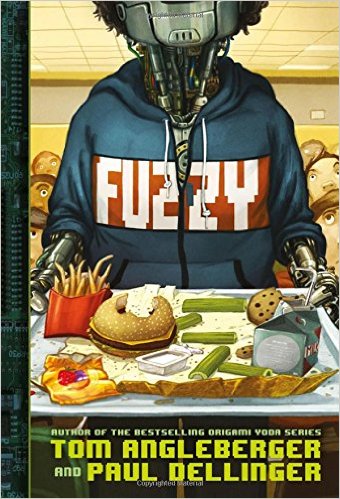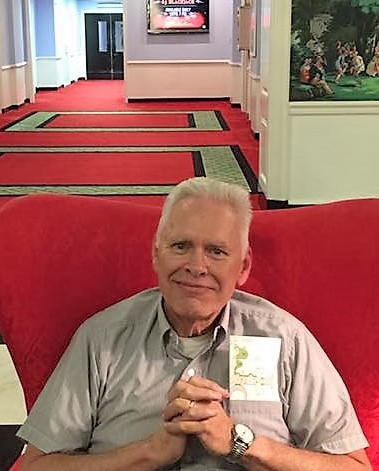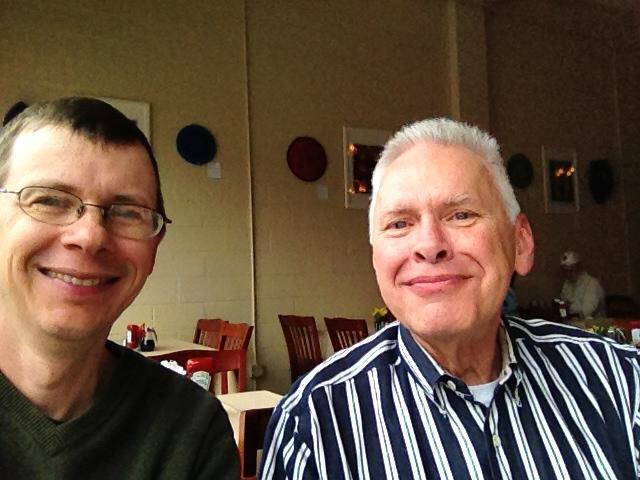I worked with both Tom Angleberger and Paul Dellinger at The Roanoke Times for many moons. But Paul’s tenure there eclipsed ours. It eclipsed everybody’s, really. For one thing, he was there a lot longer (44 years, people!) But even if he hadn’t been, he would have written more stories than the rest of us put together.
Paul was known for doing six things at a time and some of us were convinced he could be in two places at once — a coal strike in far Southwest Virginia and a science fiction convention in Roanoke. (I, for one, have seen no evidence to prove he isn’t capable of doing this.) During our years at the paper, Paul also wrote science fiction stories on the side. Then he retired and Tom, who was already well into his Origami Yoda series, knew exactly what to do with that retirement: He teamed up with Paul to work on a middle-grade novel, which was published by Abrams this month.
The novel is called Fuzzy. It’s about a girl named Max, an overbearing vice principal, and a robot who is programmed to use fuzzy logic while attending middle school in the midst of standardized-testing-obsessed America. The story got a mention in Time Magazine this month and a starred review in Kirkus. It also received a star from our family, where we’ve been passing the book around during that painful segue from summer to back to school.
 Since many folks in the kidlit community haven’t met Paul Dellinger yet (that’s Dellinger with a hard g; I mispronounced it for ages and he was too kind to correct me) I thought I would do the introductions by way of an interview.
Since many folks in the kidlit community haven’t met Paul Dellinger yet (that’s Dellinger with a hard g; I mispronounced it for ages and he was too kind to correct me) I thought I would do the introductions by way of an interview.
Me: You’ve always been drawn to science fiction. Could you tell us a little about how your love of sci-fi started?
Paul: It started in childhood, with comic books and occasional movies (there weren’t many SF movies back then, unlike today when every other new movie has at least SF elements). One of the earliest influences was probably a 1924 book called Peter and Prue by Mary Dickerson Donahey, loaned to me by a 2nd-grade teacher, a fantasy about two runaway kids visiting planets throughout our solar system and combining the science about them (as then known; I wish I could somehow get the rights to do a rewrite of it and bring that part up to date) with the Greek, Roman and Norse “gods” associated with them. It was a gem of a book. Next was the spinner-rack of paperbacks in my hometown newsstand where, again back then, the discovery of a new SF book was precious because there weren’t that many.
Me: I love the way taking things out of this world allows you to better comment on/consider this world.
Paul: I agree. People say science fiction is supposed to predict futures (and it can, in small ways) but often it’s written to avoid them (Ray Bradbury’s Fahrenheit 451, for instance; Bradbury abhorred the idea of book burnings). Neville Shute’s On the Beach and all the after-the-bomb stories that followed. And today’s dystopias are not futures we would want). Even non-SF work like Dickens’ Victorian England or Stowe’s Uncle Tom’s Cabin leave me with more of a feel for what those times were like than reading only factual history books.
Me: As you know, I was SUPER excited about the idea of you and Tom teaming up to write FUZZY. Could you talk a little bit about what the process was like, and who brought what to the story?
Paul: The concept was entirely Tom’s. At a farewell party where photographer Gene Dalton and I were retiring from The Roanoke Times, Tom came and suggested the collaboration. I’m sure he could have handled it alone, although it would be a different book, and I’m grateful for his generosity in inviting me in. I had published some science fiction stuff and he thought I could bring something to the table from that.
(Tom adds: Sure, I suggested some of the ideas, but Paul did, too. Biggs and Valentina are two of his! I think the exciting thing to me is that neither one of us would have written this book without the other one!)
Me: How did the process differ from when you worked with reporter Mike Allen on The Sky-Riders?
Paul: Mike and I (and Mike’s wife, Anita) met occasionally during the process and brainstormed research and how the story would play out. One of us would then write it, and the other would go over that and make rewriting suggestions. With Tom, we had fewer face-to-face meetings but a lot more back and forth on the internet, sending huge sections of text to one another. Toward the end when we were zeroing in on changes we needed to make, one of us would do one section and one would do another. By the end, I’m not sure we could really tell who did what.
Me: Did you and Tom ever meet over lunch (lunch being important in any middle school novel) and if so, did your food source give you inspiration?
Paul: We had a few meetings at burger places midway between where we live, where we could find corner tables and spread out our paper stuff. So we ate mostly burgers, not too inspirational. We occupied our table for much longer than it took us to eat.
Me: How did the team process differ from when you’ve worked alone?
Paul: When I’ve worked on stories solo, it’s generally been whenever I could sandwich time in front of a computer (or originally a typewriter; yes, I do go back that far. My first published short story, written while in the Army, had its first draft handwritten in a spiral notebook). I thought I’d have more time for that in retirement, but, surprise! Retirement’s been pretty busy.
(Note: During his time in the Army, where he wrote news releases and worked for the post newspaper at the U.S. Military Academy at West Point, Paul also wrote a musical comedy, which was performed at the enlisted men’s service club.)
Me: What was the best thing that came out of your recent partnership with Tom?
Paul: For me, it was coming up with a product that probably neither of us would have had alone. Plus, Tom has been very easy to work with. I don’t think we ever had any battles over where the story would go at any point. (The same was true with Mike.) We went back and forth over some things but always wound up in agreement.
Me: Have you ever tried writing for a younger audience before?
Paul: No, this was the first time.
Me: Did you make any discoveries along the way?
Paul: Let’s see…I discovered that you can radically change what would be a cliché situation simply by reversing the roles of the two characters involved. And that references to old-time western novels would be meaningless to today’s [middle grade] readers. And probably much else that I don’t recall at this moment.
Me: As someone who lives in an area where manufacturing used to be King, have you seen friends lose jobs to automation? Did that creep in to any of your thoughts as you were writing this book?
Paul: I have seen friends lose jobs for that reason, and as businesses consolidate trying to do more with fewer people. One of the adult characters in the book hates anything involving robotics for that very reason.
Me: You and Tom (and you and Mike, for that matter) have journalism in your blood. Did that have an impact on your story in any way?
Paul: We should all have deadline setting in common but, in both cases, we kind of let our projects play out to however much time it took, often interspersed with other projects we were doing. That changed toward the end of Tom’s and my book, when contract deadlines came into play and our journalism experience with deadlines no doubt helped us.
Me: So a bit off the subject, but since we’re talking robots: do you own or have you ever wanted to own a Roomba?
Paul: No. They look really efficient in TV ads, but I’m afraid we have too much furniture in the way. (Or stacks of books to knock over. My wife already says I have too many of those.)
Me: What’s the closest thing in your house to a robot?
Paul: Probably Siri, on my iPhone. You can actually have conversations with Siri, as the astronauts in 2001 did with HAL. (Does playing chess or checkers against a computer on an iPad count?)
Me: (Who owned a flip phone until two weeks ago, and who has zero experience with Siri or iPads) Yes, absolutely that counts. Have you ever tried to build a robot?
Paul: No, all I can ever remember building were Lincoln Log forts as a kid. I peopled them with toy soldiers or plastic cowboys and Indians, and staged stories in them. This may have been the primitive form of today’s sophisticated gaming. Oh, wait, I did once “build” a backyard spaceship, out of a discarded refrigerator box that I painted silver and filled inside with all kinds of fancy controls.
Me: If you had infinite programming abilities and were able to build a robot, what would you want it to do?
Paul: Housecleaning (around those stacks of books! In fact, it could catalog or alphabetize them for me), lawn-mowing, driving long distances (only when that becomes foolproof)…can’t think of much else. My preferred non-human companions are still dogs and cat. And horses. Now, when they make a robot that follows directions and looks like Marilyn Monroe – but, no, that would be an android.
Me: Star Wars or Star Trek?
Paul: I’ve thoroughly enjoyed the original versions of both. Enjoyed each a little less with each new incarnation.
Me: What are some other robot-related books that kids inspired by Fuzzy might consider?
Paul: I, Robot, by Eando Binder. I, Robot (same title, different book, actually a short story collection), by Isaac Asimov. The Humanoids by Jack Vance. “Marionettes, Inc.” by Ray Bradbury. “Helen O’Loy” by Lester del Rey. The Caves of Steel and The Robots of Dawn, both SF/mystery novels, both by Asimov, as well as his The Bicentennial Man. I read most of these as a kid so the short stories may be a little hard to track down, but the novels are still available.
Me: At the Roanoke Times, I was always blown away by how many things you could do at the same time, so the obvious question might be: what ELSE are you working on now?
Paul: I’ve been working off and on with a novel set in 1952 Hollywood but with flashbacks to the authentic old west. I needed to place it at a time when a major character could have lived during some of the historical events of the 1800s and still be functional. It’s an attempt to combine the Hollywood west with the actual one. Nobody is out there screaming for it so I haven’t set one of those deadlines to get it done.
Me: (Insert scream here.) And finally, could you tell the nice folks what you do in your free time?
Paul: Read, although not as much as I thought I would in retirement. Write, although ditto. I volunteer at the Wythe County Public Library, helping with publicity and assembling material for three of its eight monthly book clubs. I’d planned to take some community college courses but most of [my options were on-line] and I wanted actual classrooms. (I’ve instead ordered some of the Great Courses offerings with lectures on CDs and DVDs and gone through at least a dozen of those.) Occasionally, horseback riding. A friend and I do a monthly showing and providing the background for a series of vintage movies at the local community college.
Thanks, Paul!
Paul is still pondering this whole website business, but until then, you can learn more about him by visiting Abrams or by checking him out on Twitter.



I ordered it. If Madelyn says its good, I’m going to read it. Looking forward to it.